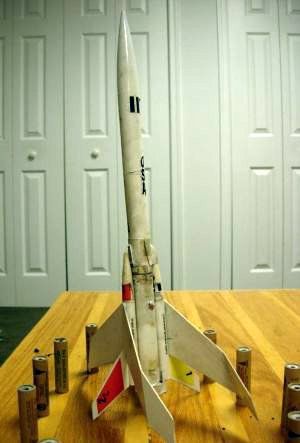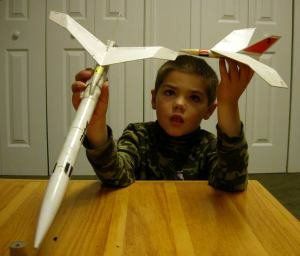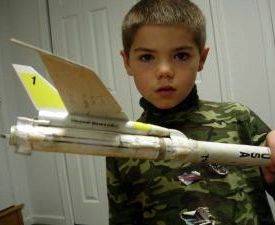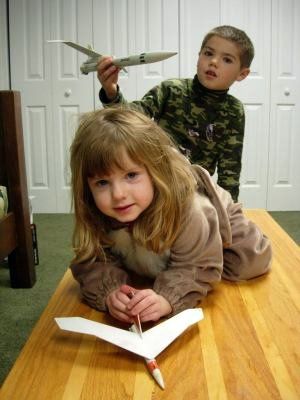| Construction Rating: | starstarstarstar_borderstar_border |
| Flight Rating: | starstarstarstarstar_border |
| Overall Rating: | starstarstarstarstar_border |
| Diameter: | 0.98 inches |
| Manufacturer: | Estes  |
| Skill Level: | 2 |
| Style: | Glider |
 Brief:
Brief:
Single stage piggy back boost launch glider design with two gliders. The glider's wings act as rocket fins during boost then separate using the ejection charge to deploy the gliders. The rocket booster body recovers with a streamer.
Construction:
The kit includes 4 body tubes. Two larger ones are for the booster and two smaller tubes for the glider fuselages. Also supplied are 3 plastic nose cones and vacuum formed thin white plastic parts to hold the nose and tail of each glider in alignment on the booster body tube.
There are good instructions that are easy to follow in the kit. No special tools are need for this kit. Care must be taken during construction of the glider wings. The wing tips angle downward from the main wing section and alignment is tricky. The kit supplies a template to get the angle just right and it is glued using tape on a flat surface. The only other tricky part is the alignment of the upper glider nose mount. Both of these must me positioned correctly so that the nose of both gliders fit in and are held in position for launch. The plastic is thin and has to be trimmed so that they don't interfere with each other as they wrap around the body tube. Build the gliders before gluing upper separation mounts in place so that you can check for proper alignment when gluing. I found this white plastic hard to work with, as regular glue didn't stick very well and I had to use some 5 minute epoxy. The bungee cord was small and short. All together it was a pretty good kit and it went together in about 2 days time, not including finishing and decals.


Finishing:
Model was painted with Testor's white spray paint from a small can. This stuff looks good but is way too heavy for the gliders!
On setup for launch, make sure gliders are lined up vertically and with each other. Having said that, after many launches it doesn't appear to be all that critical for a good boost.
I recommend leaving the paint off of the gliders and just coloring them with a bright color magic marker and then one or two coats of 50% thinned AeroGloss model airplane dope to add water resistance.
Construction Rating: 3 out of 5
Flight:
The best flights I've had are on a C6-5 because all of the paint and epoxy repairs. Use plenty of wadding so that the bungee cord and streamer do not burn or melt. The cord and streamer fit closely to the engine.
I have used C6-3 and C6-5 on the A.R.V. Condor with good trajectory every time.
Test fly your gliders by hand before launch and use the clay provided in the kit to balance them just right. One of my gliders flys great and the other one always tightens up into a spiral descent despite numerous attempts to balance and trim it with the clay. Again, I should not have painted the gliders!

Recovery:
The upper and lower body tubes fit together tightly so that there is a real pop on ejection. On the very first launch, the short shock cord pulled loose from its mount. It is probably short to prevent tangling with the gliders but after rigging a longer cord with rubber bands using a hole in the side of the lower body tube and a knot, I had no problems. The body tubes still slam together and collapse the tube openings on every launch.
When launching you need at least two people and preferably three or four with one person assigned to tracking one glider each and one to the booster. It is very cool when they all separate at apogee! Lots of stuff happening.
After more than 10 launches on this model, it looks pretty rough! The body tubes are wrinkled and the upper glider mounts have broken/come unglued and been repaired with fiberglass cloth and epoxy. After one launch, the engine stuck in the engine mount and had to be extracted with pliers causing damage to the lower body tube area and lower glider mounts. This was repaired with 3/4oz fiberglass cloth and epoxy. The streamer has numerous burn holes and melt spots. The glider nose cones have brown dirt on the tips from kids "test gliding" after recovery. The tiny launch lugs have been glued, replaced, and re-glued.
Flight Rating: 4 out of 5
Summary:
The A.R.V. Condor is a really fun! It is a good kit with well written instructions. The best part of this model is the recovery! Watching the gliders circle slowly over head is way cool!
The only problems are that you need three people to track all the descending objects at once. Not a good idea to fly this on in any kind of wind, unless you have a really big field. Also the shock cord needs to be longer. Perhaps the fit between the body tubes could be loosened up to ease the shock of ejection a bit.
Overall Rating: 4 out of 5
Other Reviews
- Estes A.R.V. Condor By Chris Taylor Jr. (January 1, 2008)
Parts and Supplies Hobby Knife, Sand Paper (220 grit), Glue (I used Thick CA), Ruler, Pen or Pencil, Desired paint etc.. Assembly Compare the parts in the box with the parts list in the instructions. Separate all balsa parts from balsa stock and sand trim as needed. Assemble wings, there are two and make sure you make a left and right for each wing set. You will use the included ...
- Estes A.R.V. Condor By Andy Sola
The A.R.V Condor is a single staged rocket that is about 19 inches long. . At apogee, two drones detach for a gliding return to Earth. Booster returns on a streamer! Recommended motors are B4-2 (First Flight), B6-2, and C6-3. The construction on this rocket wasn't as hard as I had thought it would be. After reading all the reviews I thought it would be impossible to make especially because ...
- Estes A.R.V. Condor By Eric Miller
I recently received an A. R. V. Condor as a gift from my wife. The A. R. V. Condor is an Estes Explorer series rocket (Intermediate level). This kit was packaged in plastic and came in a box and was probably around $15. 99. All the parts were included and none were damaged. The instructions were typical Estes and were excellent. The special feature of this rocket is at apogee ...
- Estes A.R.V. Condor By Carl Tulanko
The Estes Condor is a very slick kit which incorporates a sustainer with two gliders attached to the sides. The glider's airfoils act as fins for the model during boost and detach at ejection, then each glider spirals in for a landing while the main sustainer lands with the aid of a streamer. USAF insignia helps dress up this little beauty and makes it a esthetically pleasing kit to launch or ...
 |
 |
Flights
 |
 |